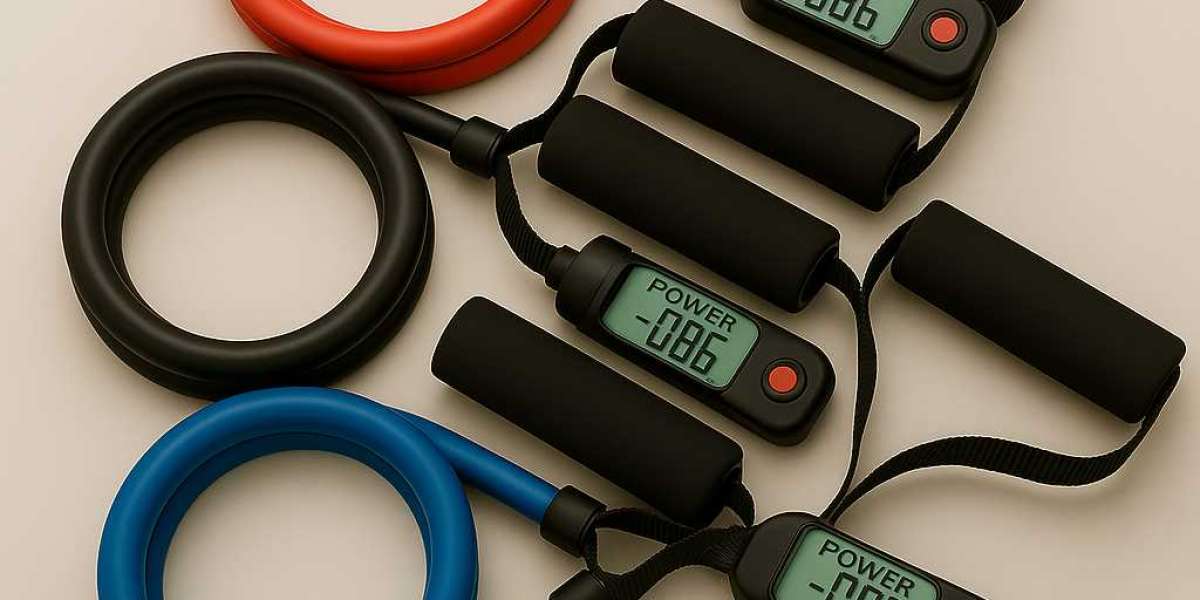Fitness trends are always evolving, and in today’s fast-paced lifestyle, people want effective, compact, and intelligent solutions to stay fit. One such innovation that is gaining popularity is Resistance Bands with Power Meter. These bands are no longer just stretchable rubber tubes — they are now smart devices that help users measure strength, track workouts, and stay motivated.
Whether you’re a fitness beginner, a home workout enthusiast, or someone who travels a lot, these resistance bands offer a powerful yet portable way to stay in shape. What makes them special is the power meter attached to them, which gives real-time data like how much force you are applying, how many repetitions you completed, and even how many calories you burned.
In this article, we will explore what makes resistance bands with power meter a game-changer in fitness. We will also discuss how to use them, what benefits they offer, what to look for before buying, and how to avoid common mistakes.
What Are Smart Resistance Bands?
Smart resistance bands are traditional elastic bands upgraded with built-in technology. These resistance bands with power meter can record your performance in real-time. A small sensor or digital display is added to the band or its handle. This sensor records force, repetitions, time, and sometimes heart rate or calories.
The data is often displayed on a small screen or synced to your smartphone via Bluetooth. This gives users instant feedback and the ability to track progress over days, weeks, or months.
With smart bands, there’s no guessing if you’re improving — the numbers speak for themselves. They’re especially helpful for people who work out alone or are just starting their fitness journey. Knowing your numbers helps adjust your form, increase your effort, and stay consistent.
What’s more, these bands can be used in all types of workouts—strength training, mobility work, stretching, and even rehab. This makes them one of the most versatile tools in modern fitness.
Benefits of Resistance Bands with Power Meter
There are many reasons why people love these advanced bands. Here are some major benefits:
1. Real-Time Performance Tracking: With power meter technology, you can see how much force you’re applying in every move. This is great motivation to push a little harder.
2. Improves Workout Form: Knowing exactly how much tension you're generating helps you focus on form and control rather than just speed.
3. Helps Set Clear Goals: You can aim to increase the power output over time or beat your own record of repetitions or workout duration.
4. Versatile and Full-Body Friendly: Smart resistance bands can target every part of your body—from arms and legs to chest and back.
5. Budget and Space Friendly: These bands cost much less than traditional gym equipment and take up little to no space.
6. Suitable for All Levels: Whether you’re a complete beginner or a fitness pro, there’s a resistance level and a plan that fits your needs.
7. Enhances Accountability: When you track progress, you're more likely to stay on course. This helps create a long-term fitness habit.
Resistance bands with power meter bring smart tracking to home workouts, helping users stay consistent and motivated.
Top Exercises to Do with Smart Bands
You can perform dozens of effective exercises using resistance bands with power meter. Here are a few that are both effective and easy to start with:
1. Standing Bicep Curl:
Stand on the middle of the band.
Hold handles and pull your hands toward your shoulders.
Great for building arm strength.
2. Chest Press (Anchor Required):
Anchor the band behind you.
Push the handles forward like a bench press.
Works chest, shoulders, and triceps.
3. Shoulder Lateral Raise:
Stand on the band.
Raise arms sideways until they’re at shoulder level.
Helps tone shoulders.
4. Seated Row:
Sit down and loop the band around your feet.
Pull the handles toward your waist.
Builds back and arm strength.
5. Squats with Resistance:
Step on the band and hold the handles by your shoulders.
Perform squats.
Builds legs, glutes, and core.
6. Glute Kickbacks:
Tie the band around your ankles.
Kick one leg backward slowly.
Great for toning the glutes.
When combined with a power meter, these exercises become more precise. You’ll know when to increase reps, reduce rest time, or add more resistance. This leads to faster, safer progress.
How to Choose the Best Smart Band
Choosing the right resistance band with power meter can be tricky with so many options available. Here are the key things to consider:
1. Resistance Level Variety: Look for bands that offer different tension levels so you can switch as you progress.
2. Accuracy of Power Meter: Make sure the power meter is tested and reviewed for accuracy. It should provide consistent readings.
3. Battery Life: Pick one with a rechargeable meter that lasts for multiple workouts.
4. Comfort and Grip: Check if the handles are cushioned and easy to hold. Comfort is key.
5. App Support: A good app can store your workouts, suggest improvements, and visualize progress with graphs.
6. Material Quality: Look for natural latex or durable rubber bands that don’t snap easily.
7. Portability: Ensure it comes with a pouch or travel bag so you can carry it easily.
Investing in a quality band ensures safety, long life, and accurate performance feedback.
Common Mistakes to Avoid During Use
Even with a smart tool like this, people sometimes make basic mistakes that reduce the effectiveness of their workout or lead to injury.
1. Skipping Warm-Up: Always warm up for 5–10 minutes to loosen muscles and avoid strains.
2. Using Wrong Resistance Level: Don’t go for high resistance right away. Gradually build up strength.
3. Poor Posture: Slouching or bending improperly can cause injury. Stand straight and engage your core.
4. Not Reading Power Meter Feedback: Don’t ignore the numbers. Use them to improve form, pace, and effort.
5. Overtraining: Using bands every day without rest can lead to fatigue. Take at least 1–2 rest days weekly.
6. Improper Storage: Avoid leaving bands in direct sunlight or near sharp objects to maintain their elasticity.
Avoiding these simple mistakes will help you stay injury-free and motivated.
A Weekly Training Plan for Beginners
Here’s a sample weekly plan using resistance bands with power meter. It’s designed for total body improvement and includes rest and recovery time.
Day 1: Upper Body Strength
Bicep curls
Shoulder presses
Seated rows
Day 2: Lower Body and Glutes
Squats
Lunges with band
Glute kickbacks
Day 3: Core and Balance
Seated crunches
Standing oblique twists
Plank with band resistance
Day 4: Rest or Active Recovery
Light stretching
Walk or yoga
Day 5: Full Body Circuit
Combine 2 exercises from each muscle group
Do 3 rounds
Day 6: Mobility and Flexibility
Use bands for stretching hips, shoulders, and hamstrings
Day 7: Rest Day
Track your progress daily using the power meter. Adjust reps and resistance as you improve. This keeps workouts challenging and effective.
Conclusion
Resistance Bands with Power Meter are a smart, affordable, and space-saving way to bring technology into your workout routine. Whether you are a complete beginner or someone looking to take home workouts to the next level, these bands offer everything you need — from strength training to detailed performance feedback.
With consistent use, proper form, and smart tracking, you can build strength, lose fat, and stay active—anytime and anywhere. Just remember to start slow, listen to your body, and track your numbers. Fitness becomes fun and achievable when you can measure your progress.
So, if you want to stay fit in a smart and simple way, it’s time to try resistance bands with power meter.
Frequently Asked Questions (FAQs)
Q1: What is the power meter in resistance bands?
It’s a smart sensor that tracks your effort, including reps, force, and calories burned.
Q2: Are these bands good for home use?
Yes, they are compact and easy to use at home or on the go.








